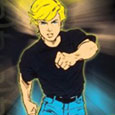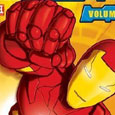Filmation (1980-1981), BCI (July 15, 2008), 2 discs, 396 mins plus supplements, 1.33:1 original full frame ratio, Dolby Digital 2.0 Mono, Not Rated, Retail: $14.98
Storyboard:
Two icons of the American West pursue evildoers on horseback, bringing justice to the people.
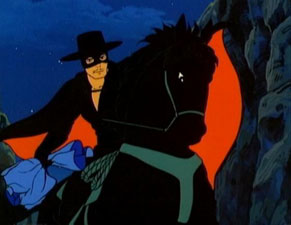
The Sweatbox Review:
Further history and comments on these shows may be found in our review of the first volume.
The short review here is, “If you liked the last one, you’ll like this one.” Yes, second volume reviews are tricky, particularly when they don’t even break up evenly into seasons. In this case, this set completes the initial half-hour episodes originally done for The New Adventures Of The Lone Ranger by including the final five of these; and the first disc also has the twelve quarter-hour segments done for the following season. This makes for a total of seventeen Lone Ranger tales, and over four hours of runtime of the first disc. That is a whole lot of silver bullets! Moving on to the second disc, we get the balance of the New Adventures Of Zorro episodes, making for seven adventures and what seems like dozens of swordfights (not that that’s a bad thing). In the review of the first volume, we covered the history of the show already, so this time let’s take an overview of the actual episodes.
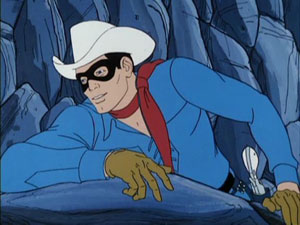
The New Adventures Of The Lone Ranger
The five half-hour (okay, 22 minute) episodes included here are very similar to what we saw in the last set, while the shorter stories are naturally a little simpler. Anyone who has ever seen the Clayton Moore television series of the 1950s will feel very at home with these shows, as they use many of the same elements. The Ranger’s pants are a little more skin-tight, but otherwise he and Tonto keep pretty much the same appearance. The William Tell Overture still plays often, Silver is a pretty handy horse, and the Ranger’s strong sense of morality never wavers. Of course, this being a Saturday morning cartoon of the early Eighties, there’s a lot less violence than what one might otherwise expect. For all the gunplay, no one ever gets shot, but the Lone Ranger certainly can do some fancy tricks with bullets instead. The other main piece that reminds you of the show’s origins are the historical tags at the end of each episode, letting the viewer know more about famous people or events depicted in the story.
For example, the first episode on the set, The Wildest Wild West Show, prominently features the showmanship of Buffalo Bill Cody and Annie Oakley. In this one, the Lone Ranger takes on the identity of an outlaw in order to infiltrate a criminal gang. A few episodes later, in The Memory Trap, the Lone Ranger really does look to hook up with the Jesse James gang after losing his memory. Later guests in the shorter episodes include photographer Matthew Brady, naturalist John Muir, inventors George Pullman (the Pullman sleeping car) and Alfred Nobel (dynamite), and the Pony Express. Having historical figures does add some authenticity to the tales, though it’s hard to escape the feeling that they are used as stunts. On the whole, I enjoy it when they show up, as it does bring the old West alive and helps to place these figures in some sort of context, albeit fictionalized.
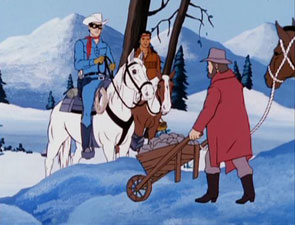
On the way, our heroes also run into problems concerning the mine where the Ranger gets his silver bullets (The Silver Mine), counterfeiters (Front Page Cover-Up), a stolen sapphire (Showdown On The Midnight Queen), and cattle rustlers (Renegade Roundup). Though these may be pretty typical set-ups for western stories, it’s always fun to see them told with the prototypical masked cowboy. Of course, there’s another masked cowboy who is no slouch himself…

The New Adventures Of Zorro
The main difference between The Lone Ranger and Zorro, aside from Zorro’s Spanish influences, is that Zorro maintains a secret identity. This figures into his stories, as he is able to utilize his everyday identity, the foppish Don Diego, to gain information and provide a front for his nocturnal activities. He also has a recurring adversary, Captain Ramon, who is keen to learn Zorro’s true identity. These differences prevent Zorro from seeming too similar to The Lone Ranger, and give his adventures a whole different feel. All of these seven episodes are half-hour ones and show some nice variety.
Terremoto! sees Zorro and his companion Miguel allow themselves to be arrested in order to help free some innocent prisoners. Next, Zorro and Miguel must avoid The Trap set by Captain Ramon. Then, the captain takes over a religious mission in order to construct Fort Ramon. A bandit who plans to assume control of a local government kidnaps Zorro’s friends in The Takeover. The show then gets its mandatory doppelganger episode in Double Trouble, but this double is a young writer who takes his research too far. Zorro must take on both Captain Ramon as well as the femme fatale Lucia the pirate, as they are after a fortune in taxes being shipped to Spain in The Conspiracy. Lastly, The Mysterious Traveller is female with an amazing connection to the king of Spain.

Both The Lone Ranger and Zorro may be simple tales of straightforward heroes and villains, but these are the types of heroes that I enjoy. I’m no western fan normally, but I do like masked men and swashbucklers, particularly when they dole out justice with such style. Really, you just can’t beat the classics, even when done in limited animation. Compared to a lot of the dreck that is out there today, the cartoons in this set are worth their weight in silver.
Is This Thing Loaded?
On Disc Two, four Interviews are provided, with Filmation Producer Lou Scheimer, Zorro writer bobby London, Lone Ranger layout artist Darrell McNeil, and network executive Ted Field II. The interviews run 4-10 minutes each, for a total of about 20 minutes.
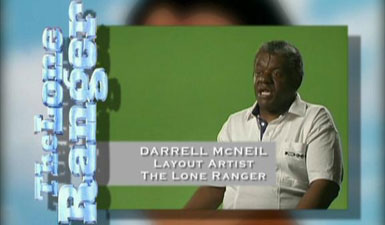
While some artwork would have been great, or maybe a featurette on the origins of the characters, these interviews do constitute some decent behind-the-scenes stories.
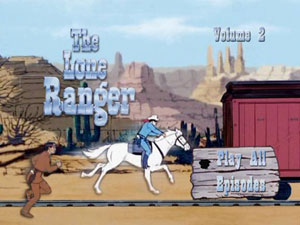
Case Study:
This second set of episodes uses the same packaging set-up as the first volume, while giving Zorro the spine position this time, making for a nice companion for the first set while the two sit next to each other on your shelf. The double-thick keepcase opens in two places to present each disc separately. A four-page episode guide appears as a welcome insert. The keepcase is held by an almost identical slipcase that simply moves the company logos on the back and brings the copyright warnings to the bottom surface of the case. The back cover incorrectly states that the set has only eleven Lone Ranger adventures (it’s about eleven half-hours, but seventeen stories, due to most of them being quarter-hours).

Ink And Paint:
Just squint a bit, and these will look okay. If you don’t feel like squinting, then be prepared to put up with an undistinguished transfer that likely comes from a PAL source. Video noise is prominent, focus is soft, and some disappearing lines suggest DVNR. It’s probably on about the same level of what you could expect if you were watching this show over the air using your rabbit ears.

Scratch Tracks:
While the audio on The Lone Ranger is merely okay, there are real problems with Zorro’s soundtrack, which echoes badly and has uneven volume levels. The effect is rather distracting at times. If this is the best master that could be found, it’s rather sad. Only English 2.0 is available, and there are no subtitles.

Final Cut:
The stories presented in this two-disc set do reflect the fact that they were aimed at children, with simple plots and morality, but simple does not mean boring. These are still entertaining adventure stories featuring classic heroes, presented in classy fashion by Filmation. Though the substandard video and audio threaten to sabotage the set, I still found it to be a treat worth sampling.
 | ||
 |









